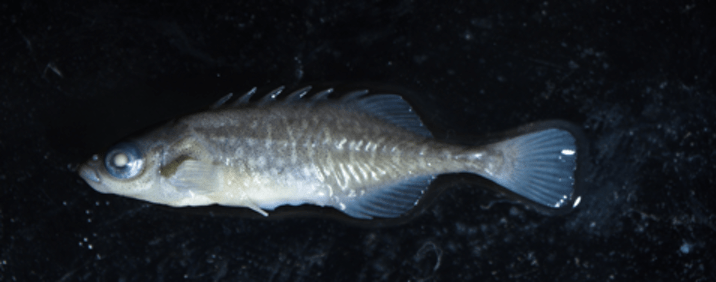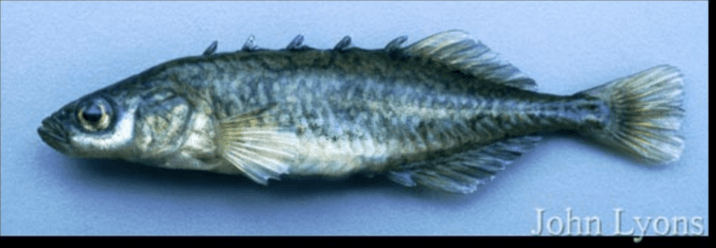Key Characteristics:
- Preanal myomeres: 14-16
- Postanal myomeres: 15-18
- Vitiline vessels over yolk in yolk sac larvae

Larval Brook Stickleback. 25 mm. United States Fish Wildlife Service. Green Bay, WI. Adam Dziewa. 2018.

Juvenile Brook Stickleback. 49 mm. United States Fish Wildlife Service. Green Bay, WI. Adam Dziewa. 2018.
- Body not elongated, eel-shaped, round in transverse section, uniformly pigmented (1B)
- Chin barbels absent (3B)
- Snout short, its length usually less than 10% TL; median fins otherwise (5B)
- Median fins or finfolds showing distinct separation (7B)
- No adipose fin, or demarcation of one, in finfold (10B)
- Preanal myomeres greater than or equal to postanal myomeres (14A)
- Preanal myomeres approximately equal to postanal myomeres (difference five myomeres or less) (15A)
- Total myomeres less than 35 (20B)
- Total myomeres between 26 and 34 (21B)
- Adipose fin or its position absent (23B)
- Single Dorsal Fin (24B)
- Caudal peduncle narrow; total myomeres greater than or equal to 31 (25B) Gasterosteidae
Adult History
- Physical Description
- 4-6 unconnected dorsal spines, spots on sides (green, gray, brown, and black), torpedo-shaped body (brown), compressed scale-less body, narrow caudal peduncle, abdominal-pelvic fin (single spine), anal fin (1 spine & 9-10 rays)
- Spawning Habitat
- Under some cover (dead plant matter, rocks, overhanging banks, etc)
- Between 10 – 30 cm deep
- Spawning Substrate
- Eggs are deposited on organic debris, plants, duckweed, algae, or sticks
- Eggs can attach to plant stems or under twigs under the water
- The bottom can consist of organic debris, sand, or both
- Spawning Behavior
- Polygynandry Behavior
- During spawning, males have darker colored bodies with copper or red fins
- Move from deeper water to shallow warmer water with plenty of vegetation
- Males establish territories and construct nests
- Male defends nest with lateral displays of aggression
- Courtship Display: Tail Flagging
- A dance in which the male swims towards the female with his head down while waving his tail back and forth
- Female will either swim towards the nest, remain motionless, drop to the bottom, or leave for another nest
- Males can build or maintain multiple nests
- Males provide oxygen to eggs by fanning his tail
- Male pulls apart the nest to create a hatchery for his larvae after 9-11 days
- Time of Year
- April – June in Great Lakes
- Spawning typically takes place at water temperatures of 60 – 66°F
- Spawning is inhibited above 66°F
- Nest building takes place at water temperatures of 40 – 50°F
- Diet
- Algae, eggs, insects, and aquatic crustacean

